Empirical Validation and Numerical Predictions of an Industrial Borehole Thermal Energy Storage System
Abstract
:1. Introduction
2. Description of the Site and the Modelled BTES
3. Numerical Procedure
3.1. Numerical Model
- One-dimensional heat transfer between downward and upward flow
- One-dimensional heat transfer between grout (backfill material), liquid and ground
- Two-dimensional heat transfer around the borehole and between the grout and the liquid, using a mesh of cylindrical coordinates
3.2. The Modelled System and Validation Setup
3.3. Parametric Study
4. Results and Discussion
4.1. Model Validation and Time-Step Dependency
4.2. Parametric Study
4.2.1. Borehole Spacing
4.2.2. Borehole Depth
4.2.3. Ground Thermal Conductivity
4.2.4. Useful Storage Temperature
5. Conclusions
- For the investigated storage supply flows at heat injection, 10–20 l/s and 40–80 °C, a high temperature in the supply flow was more important than a high flow rate in order to achieve high annual heat extractions
- For a BTES there is a borehole spacing and depth at which heat extraction is the highest, which are possible to determine with the use of a numerical model such as the one used in this study
- Annual heat extraction quickly reduced as the spacing was decreased from the spacing yielding the highest annual heat extraction, whereas the reduction in annual heat extraction was quite slow when the spacing was increased from this point.
- Annual extracted energy was barely affected by a change in the effective ground thermal conductivity. However, the impact of the effective ground thermal conductivity is likely to have been greater at a higher temperature difference between the storage supply flow and the minimum storage temperature considered useful.
- Annual energy that could be extracted from the storage increased almost linearly with a decrease in the minimum storage temperature considered useful when the latter was decreased from 40 to 30 °C.
Author Contributions
Funding
Acknowledgments
Conflicts of Interest
References
- Rad, F.M.; Fung, A.S. Solar community heating and cooling system with borehole thermal energy storage -review of systems. Renew. Sustain. Energy Rev. 2016, 60, 1550–1561. [Google Scholar] [CrossRef]
- Başer, T.; Lu, N.; McCartney, J.S. Operational response of a soil-borehole thermal energy storage system. ASCE J. Geotech. Geoenviron. Eng. 2015, 142, 04015097. [Google Scholar] [CrossRef]
- Gao, L.; Zhao, J.; Tang, Z. A review on borehole seasonal solar thermal energy storage. Energy Procedia 2015, 70, 209–218. [Google Scholar] [CrossRef]
- Pavlov, G.K.; Olesen, B.W. Seasonal solar thermal energy storage through ground heat exchangers-Review of systems and applications. In Proceedings of the 6th Dubrovnik Conference on Sustainable Development of Energy, Water and Environment Systems, Dubrovnik, Croatia, 24–28 September 2011. [Google Scholar]
- Başer, T.; McCartney, J.S. Transient evaluation of a soil-borehole thermal energy storage system. Renew. Energy 2018. [Google Scholar] [CrossRef]
- Choi, J.C.; Lee, S.R.; Lee, D.S. Numerical simulation of vertical ground heat exchangers: Intermittent operation in unsaturated soil conditions. Comput. Geotech. 2011, 38, 949–958. [Google Scholar] [CrossRef]
- Nordell, B.; Hellström, G. High temperature solar heated seasonal storage system for low temperature heating of buildings. Sol. Energy 2000, 69, 511–523. [Google Scholar] [CrossRef]
- Gehlin, S.; Andersson, O. Geothermal Energy Use, Country Update for Sweden. In Proceedings of the European Geothermal Congress 2016, Strasbourg, France, 19–23 September 2016. [Google Scholar]
- Lundh, M.; Dalenbäck, J.-O. Swedish solar heated residential area with seasonal storage in rock: Initial evaluation. Renew. Energy 2008, 33, 703–711. [Google Scholar] [CrossRef]
- Bauer, D.; Marx, R.; Nußbicker-Lux, J.; Ochs, F.; Heidemann, W.; Müller-Steinhagen, H. German central solar heating plants with seasonal heat storage. Sol. Energy 2010, 84, 612–623. [Google Scholar] [CrossRef]
- Sibbitt, B.; McClenahan, D.; Djebbar, R.; Thornton, J.; Wong, B.; Carriere, J.; Kokko, J. The performance of a high solar fraction seasonal storage district heating system-five years of operation. Energy Procedia 2012, 30, 856–865. [Google Scholar] [CrossRef]
- Giordano, N.; Comina, C.; Mandrone, G.; Cagni, A. Borehole thermal energy storage (btes). First results from the injection phase of a living lab in torino (nw italy). Renew. Energy 2016, 86, 993–1008. [Google Scholar] [CrossRef]
- Lhendup, T.; Aye, L.; Fuller, R.J. Thermal charging of boreholes. Renew. Energy 2014, 67, 165–172. [Google Scholar] [CrossRef]
- Lanini, S.; Delaleux, F.; Py, X.; Olives, R.; Nguyen, D. Improvement of borehole thermal energy storage design based on experimental and modelling results. Energy Build. 2014, 77, 393–400. [Google Scholar] [CrossRef] [Green Version]
- Catolico, N.; Ge, S.; McCartney, J.S. Numerical modeling of a soil-borehole thermal energy storage system. Vadose Zone J. 2016, 15. [Google Scholar] [CrossRef]
- Giordano, N.; Kanzari, I.; Miranda, M.M.; Dezayes, C.; Raymond, J. Underground Thermal Energy Storage in Subarctic Climates: A Feasibility Study Conducted in Kuujjuaq (QC, Canada). In Proceedings of the International Ground Source Heat Pump Association, Stockholm, Sweden, 18–19 September 2018. [Google Scholar]
- Xu, L.; Torrens, I.; Guo, F.; Yang, X.; Hensen, J.L.M. Application of large underground seasonal thermal energy storage in district heating system: A model-based energy performance assessment of a pilot system in chifeng, china. Appl. Therm. Eng. 2018, 137, 319–328. [Google Scholar] [CrossRef]
- Cui, P.; Diao, N.; Gao, C.; Fang, Z. Thermal investigation of in-series vertical ground heat exchangers for industrial waste heat storage. Geothermics 2015, 57, 205–212. [Google Scholar] [CrossRef]
- Long-Term Performance Measurement of Gshp Systems Serving Commercial, Institutional and Multi-Family Buildings. Available online: https://heatpumpingtechnologies.org/annex52/wp-content/uploads/sites/60/2017/11/legaltextieahptannex52v1320171023.pdf (accessed on 10 January 2019).
- Nilsson, E.; Rohdin, P. Performance evaluation of an industrial borehole thermal energy storage (btes) project-Experiences from the first seven years of operation. Renew. Energy 2019, 143, 1022–1034. [Google Scholar] [CrossRef]
- Nordell, B.; Liuzzo Scorpo, A.; Andersson, O.; Rydell, L.; Carlsson, B. The HT BTES Plant in Emmaboda; Division of Architecture and Water, Luleå Unversity of Technology: Luleå, Sweden, 2016. [Google Scholar]
- Bring, A.; Sahlin, P.; Vuolle, M. Models for Building Indoor Climate and Energy Simulation; Department of Building Sciences, KTH Royal Institute of Technology: Stockholm, Sweden, 1999. [Google Scholar]
- Achermann, M. Validation of Ida Ice, version 2.11.06; Hochschule Luzern: Luzern, Sweden, 2000. [Google Scholar]
- Description of the Ida Ice Borehole Model. EQUA Simulation AB. Available online: www.equa.se (accessed on 1 September 2018).
- Fadejev, J.; Kurnitski, J. Geothermal energy piles and boreholes design with heat pump in a whole building simulation software. Energy Build. 2015, 106, 23–34. [Google Scholar] [CrossRef]
- Li, M.; Lai, A.C.K. Review of analytical models for heat transfer by vertical ground heat exchangers (ghes): A perspective of time and space scales. Appl. Energy 2015, 151, 178–191. [Google Scholar] [CrossRef]
- Patricia, M. Modelling and Monitoring Thermal Response of the Ground in Borehole Fields. Ph.D. Thesis, KTH Royal Institute of Technology, Stockholm, Sweden, 2018. [Google Scholar]
- Incropera, F.P.; Dewitt, D.P.; Bergman, T.L.; Lavine, A.S. Fundamentals of Heat and Mass Transfer, 6th ed.; John Wiley & Sons Inc.: Hoboken, NJ, USA, 2006. [Google Scholar]
- Eppelbaum, L.; Kutasov, I.; Pilchin, A. Applied Geothermics; Springer: Berlin/Heidelberg, Germany, 2014. [Google Scholar]
- Welsch, B.; Rühaak, W.; Schulte, D.O.; Bär, K.; Sass, I. Characteristics of medium deep borehole thermal energy storage. Intern. J. Energy Res. 2016, 40, 1855–1868. [Google Scholar] [CrossRef]
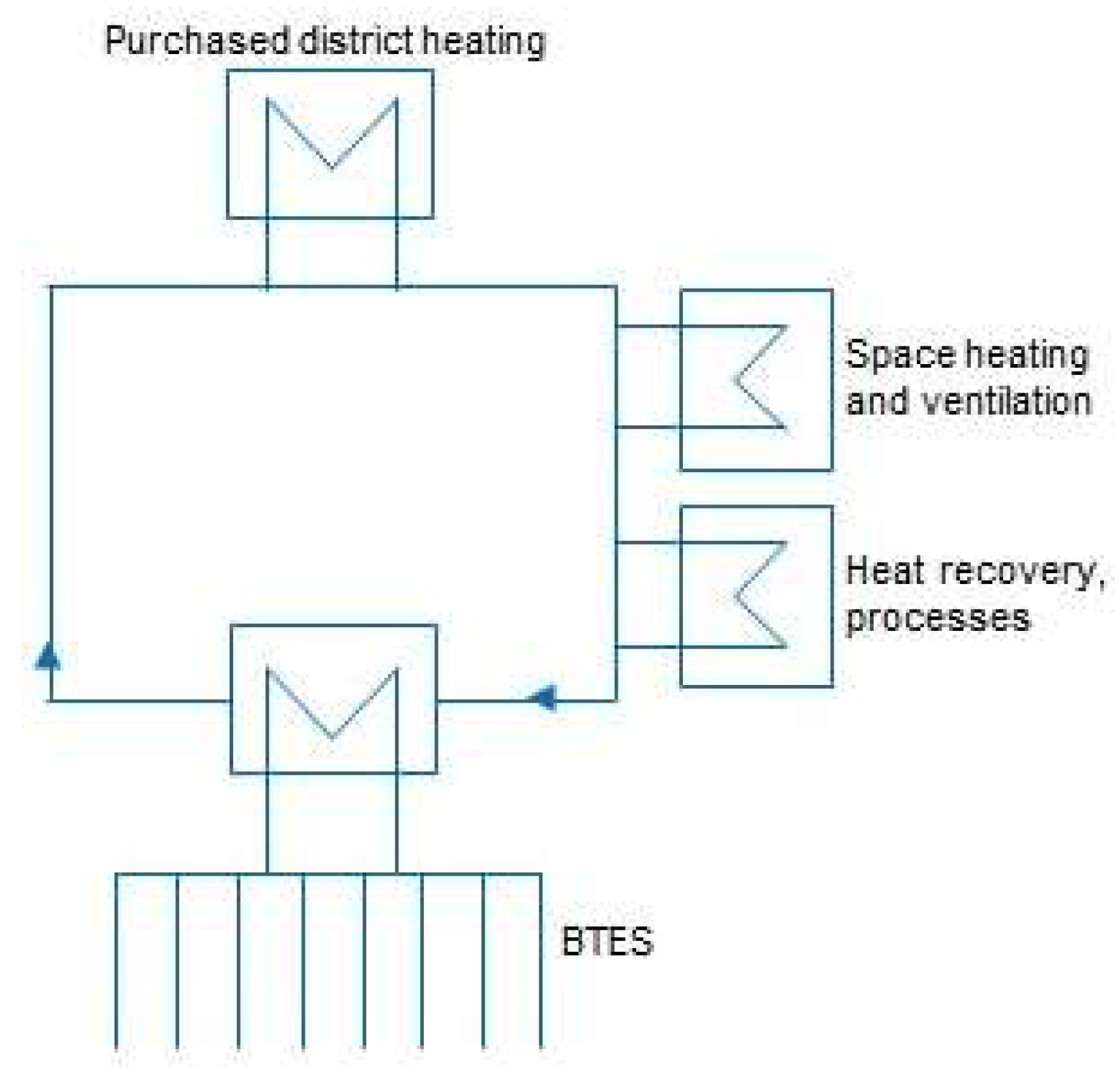

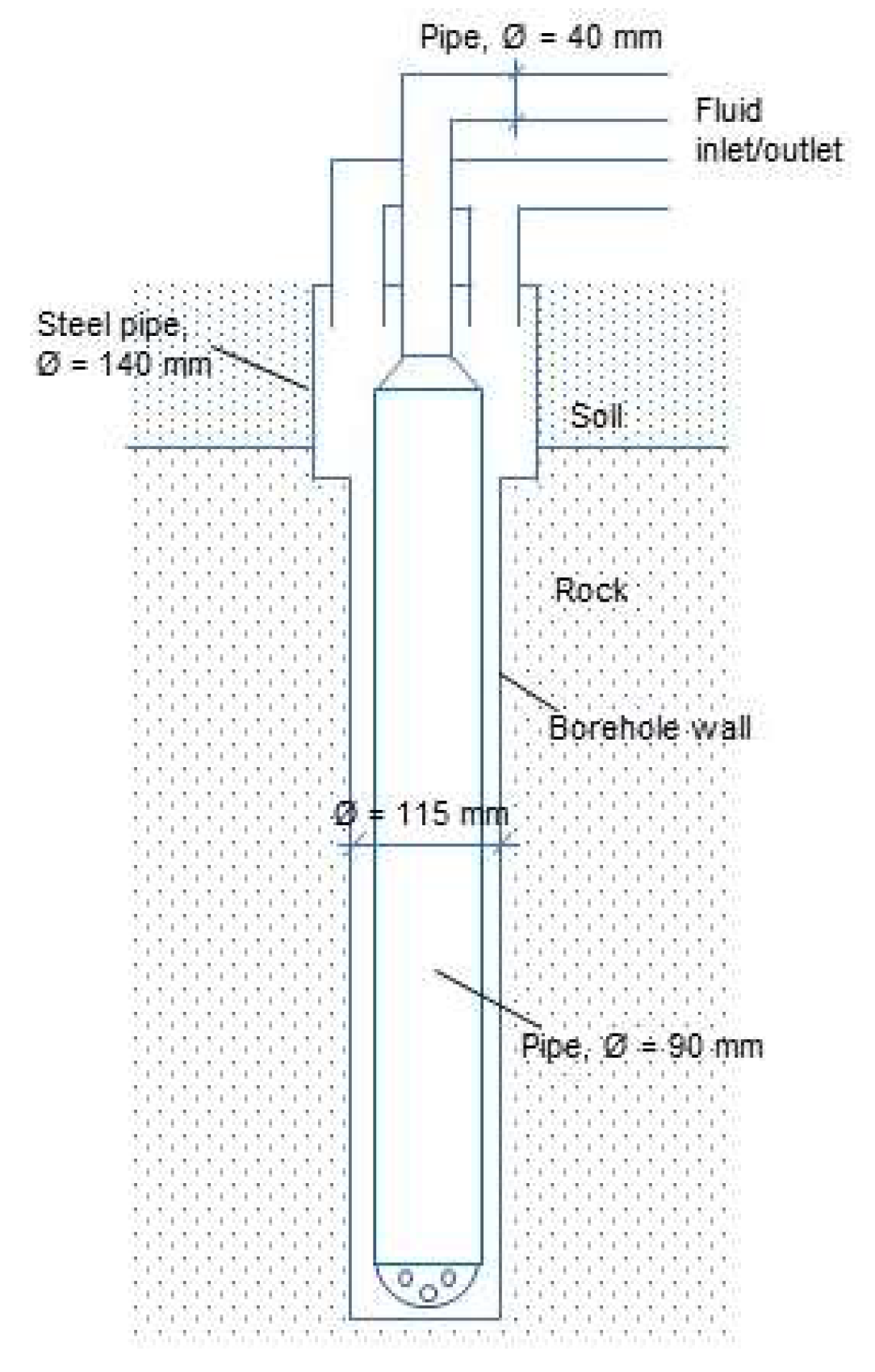
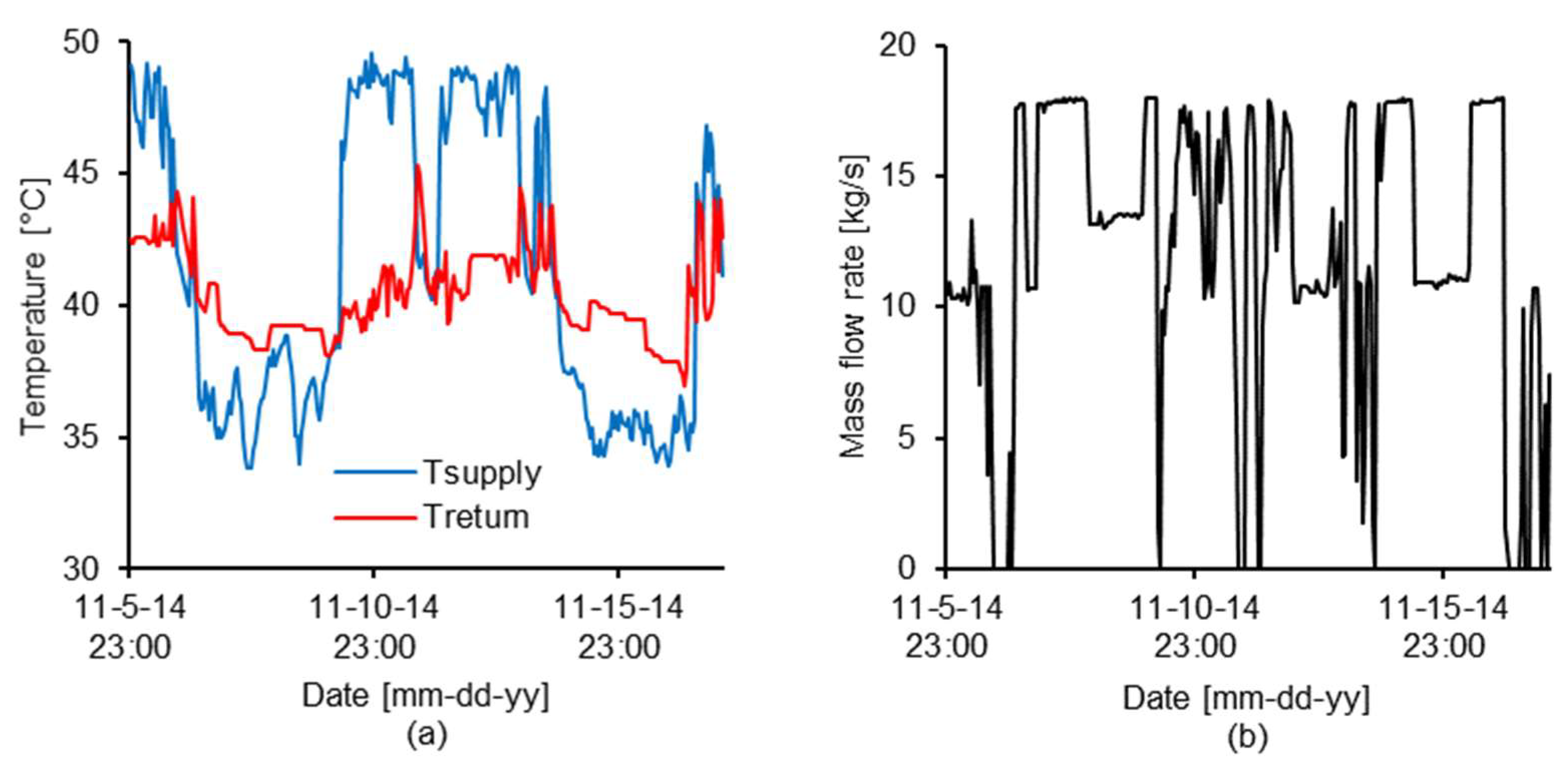
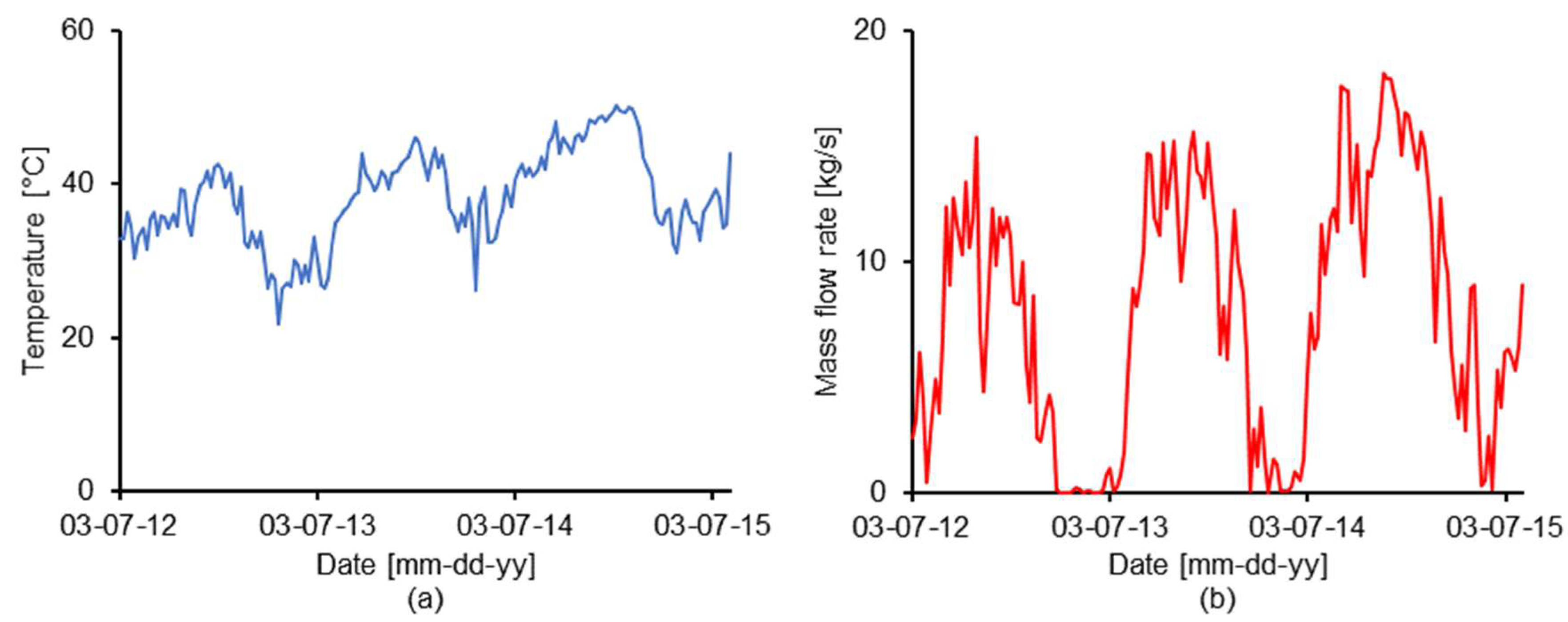
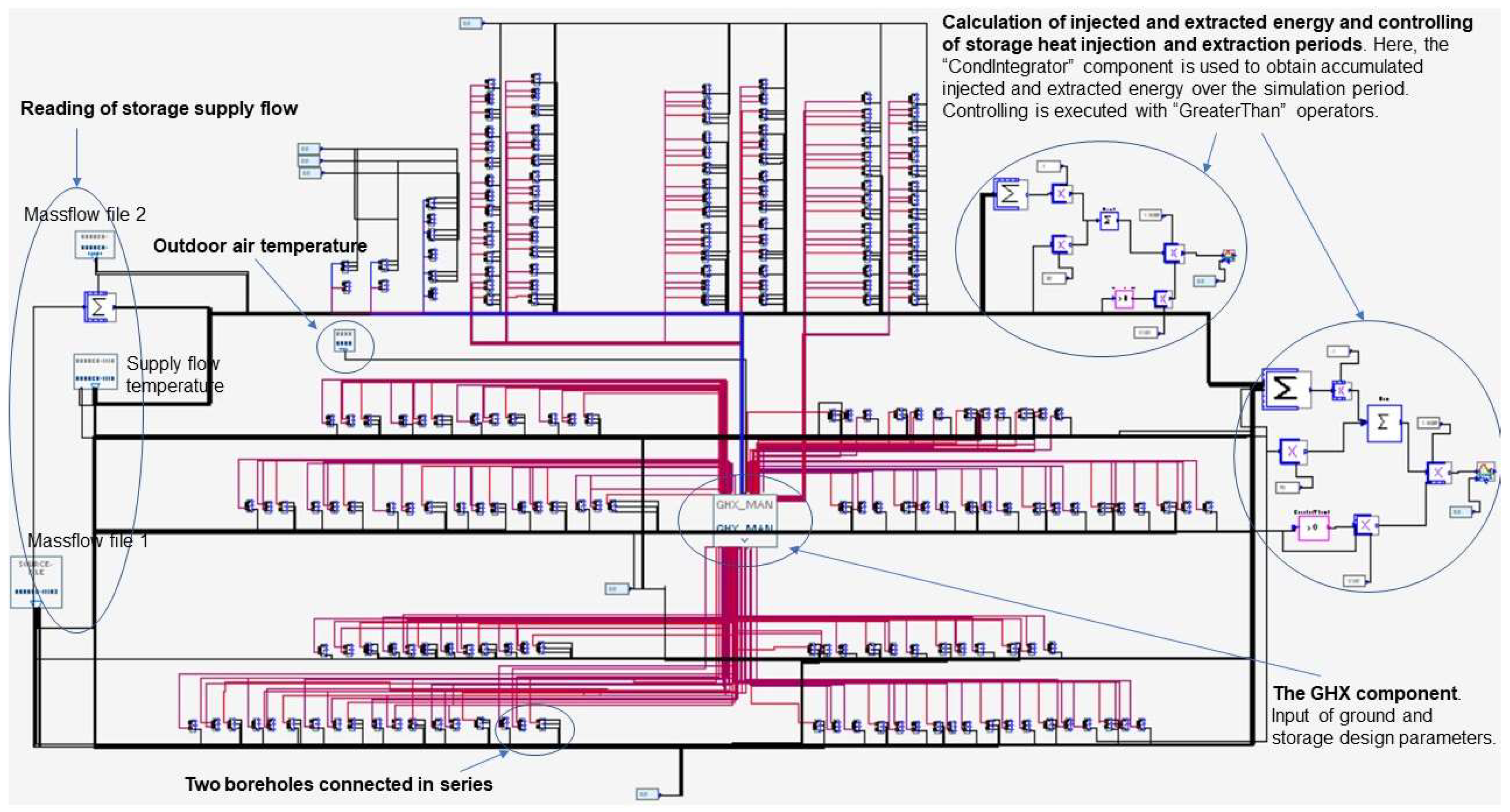


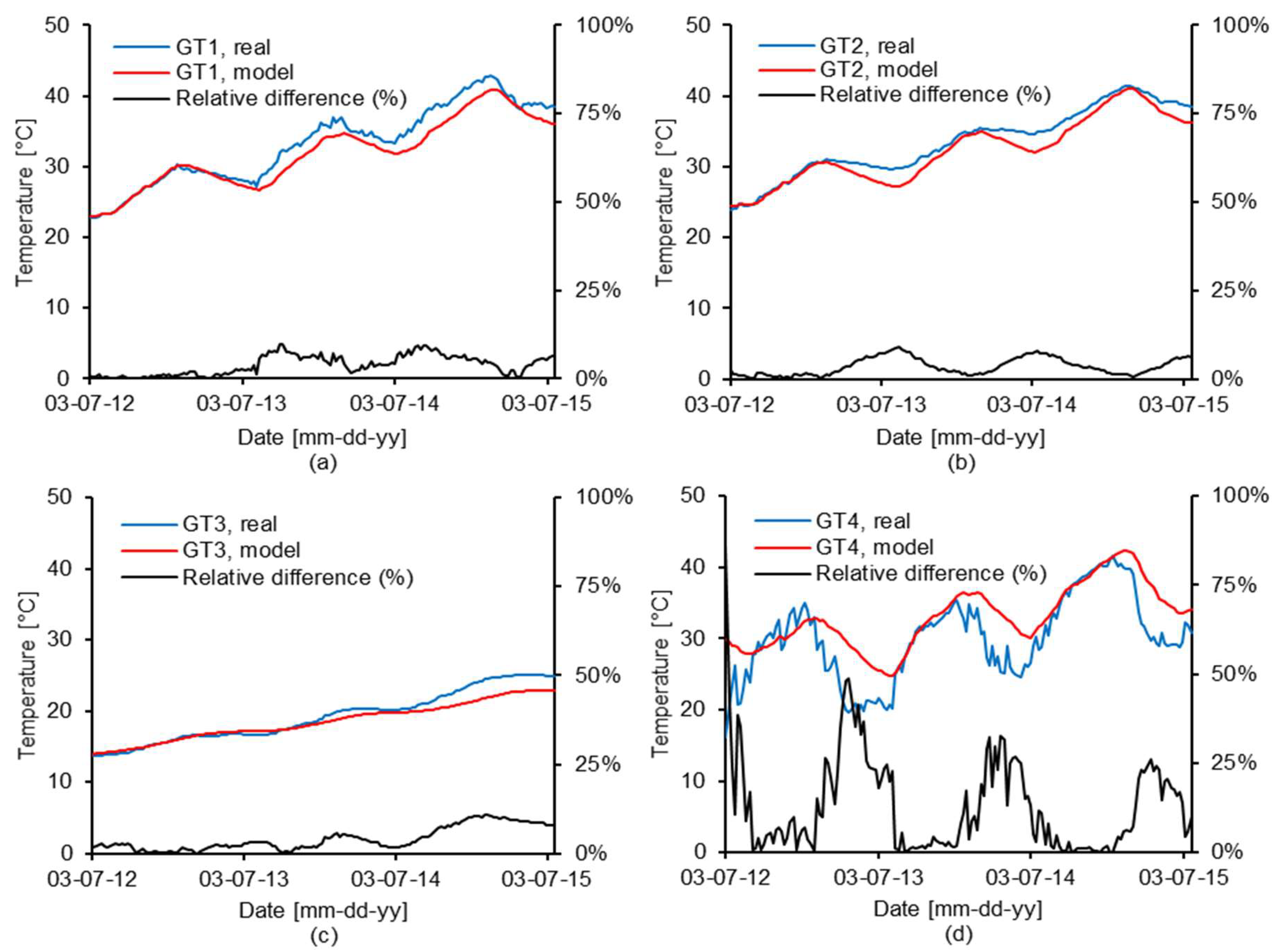
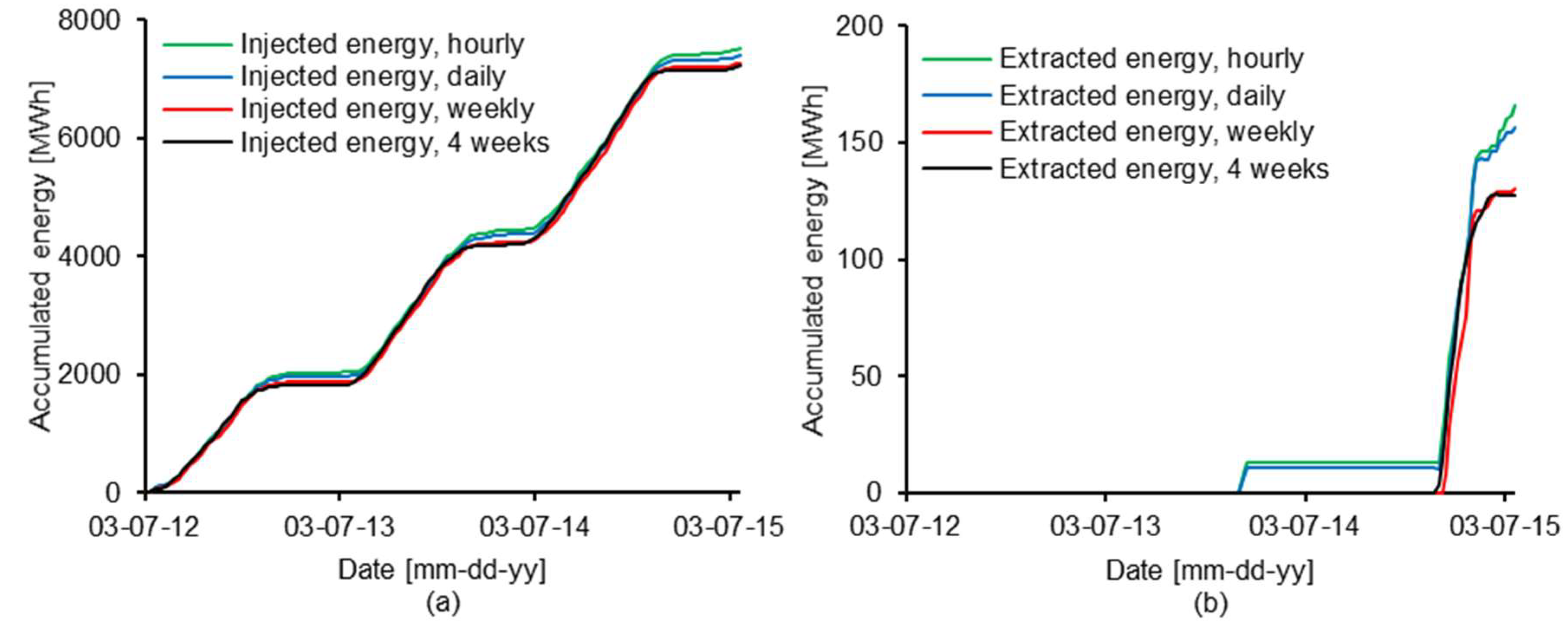
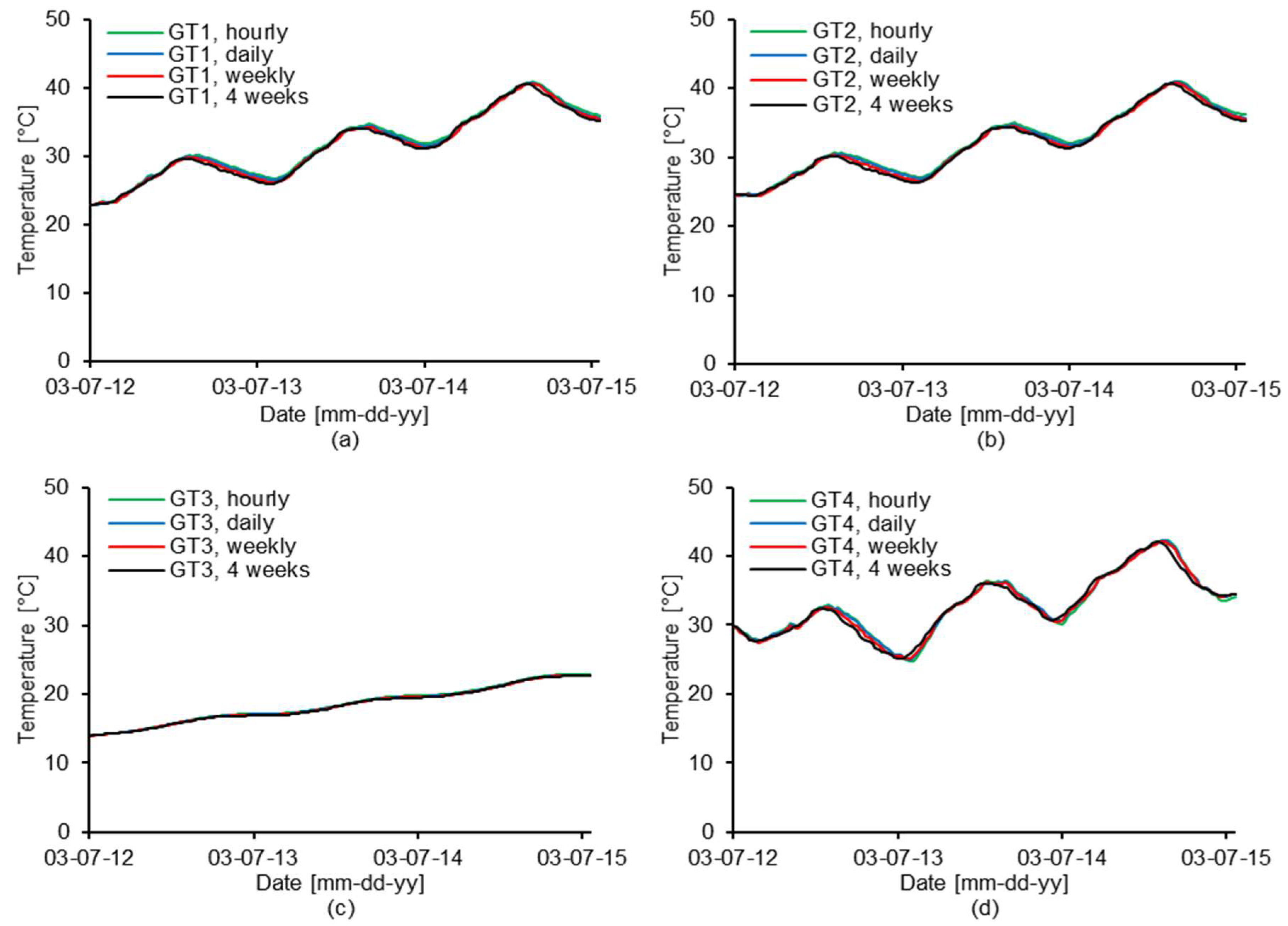
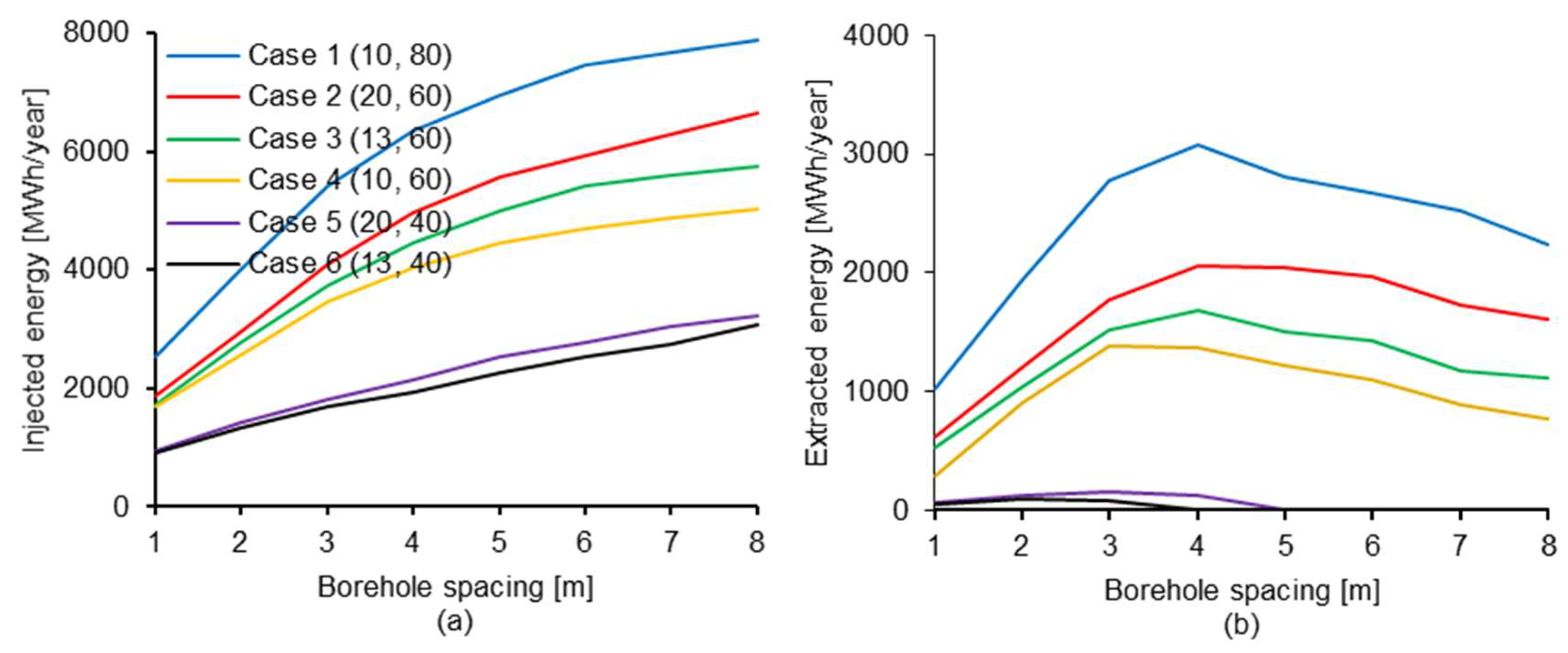
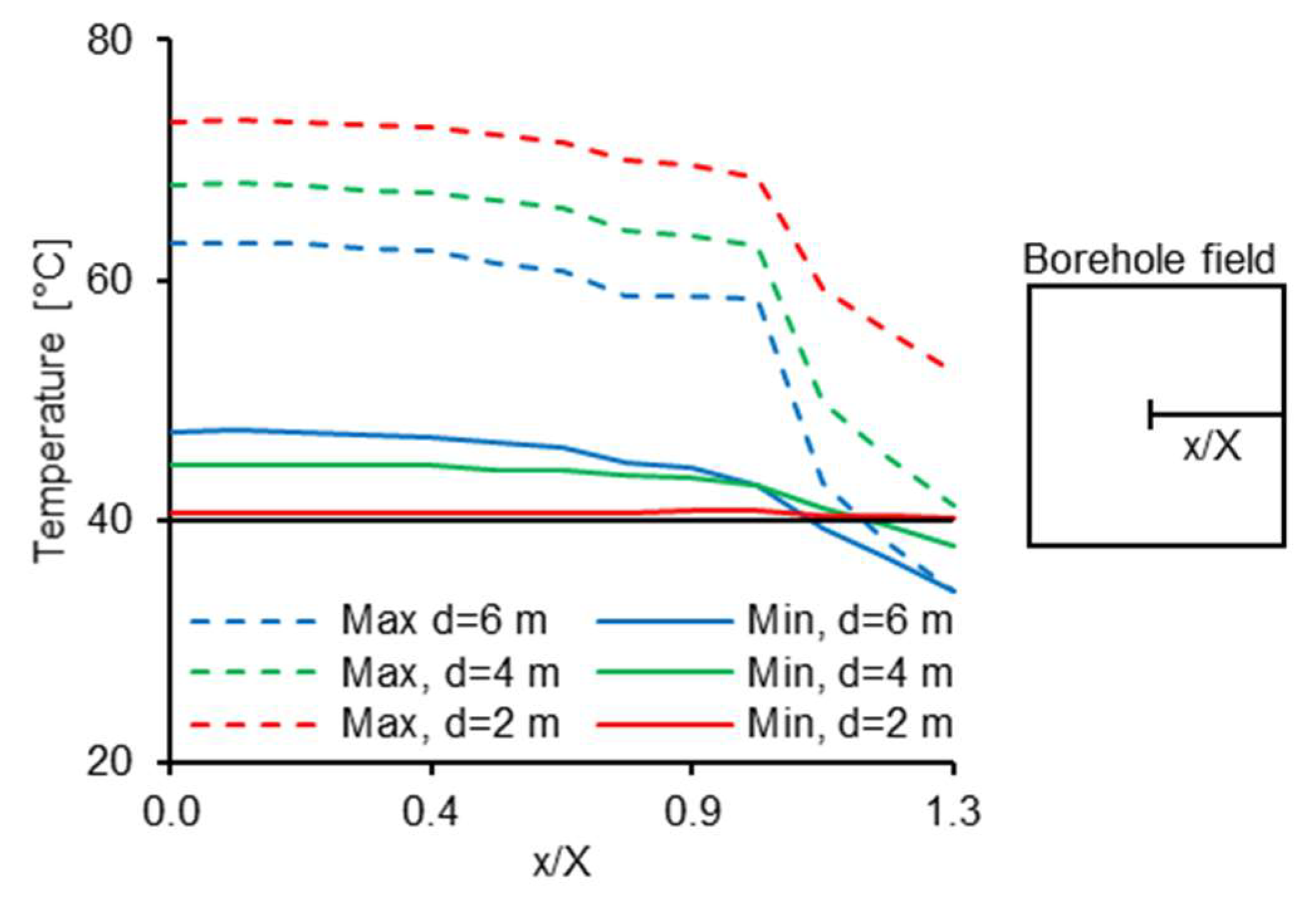
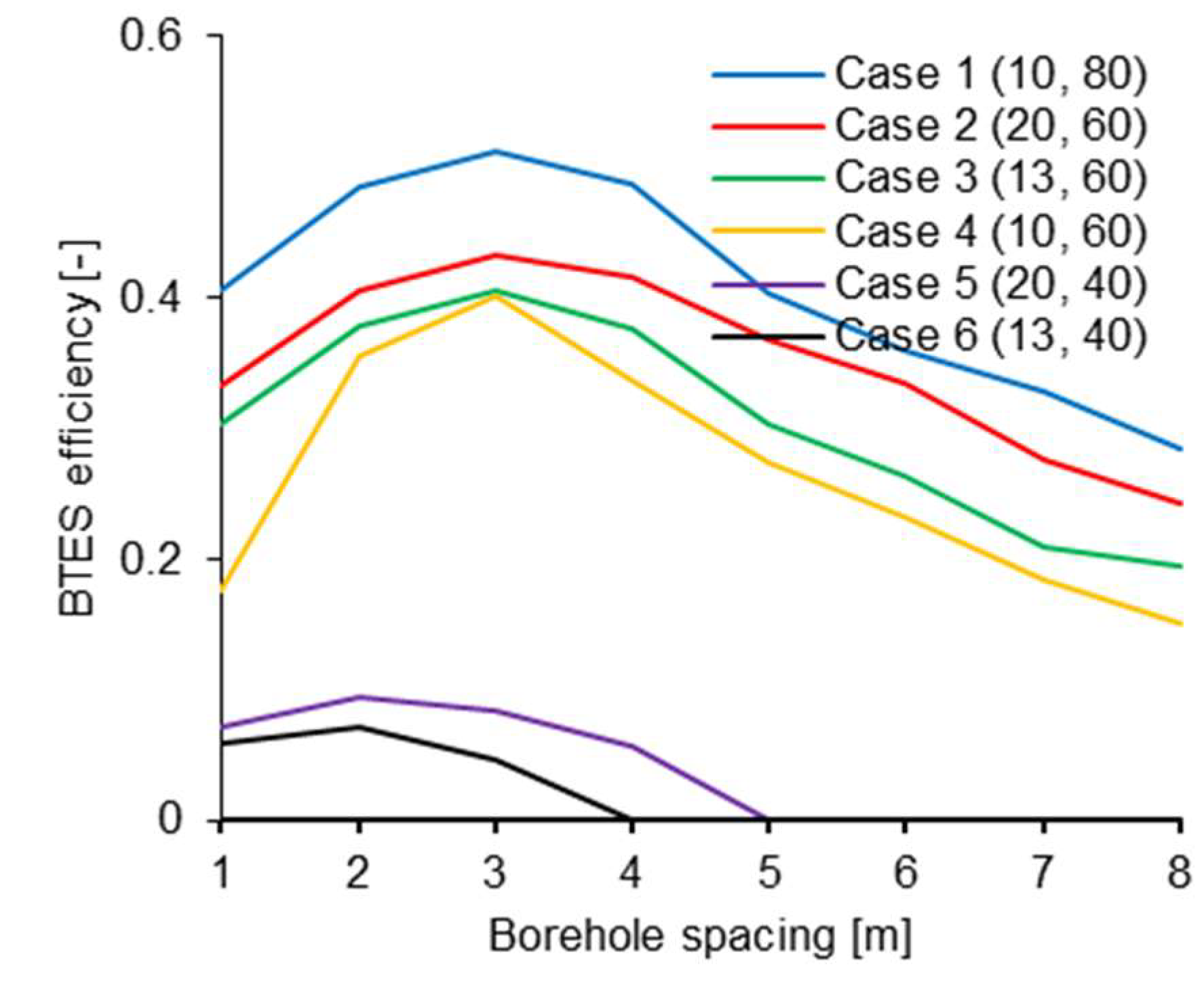
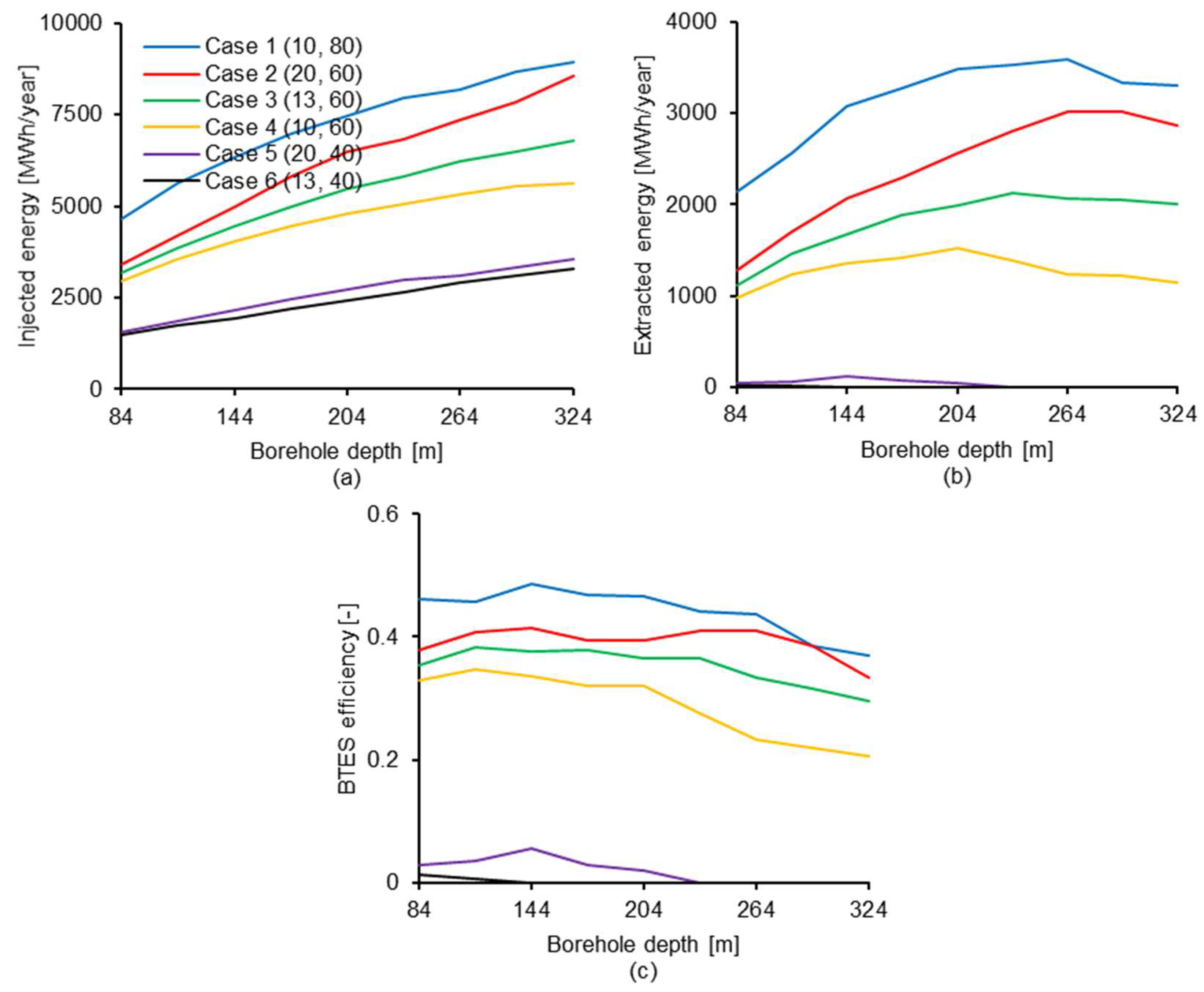
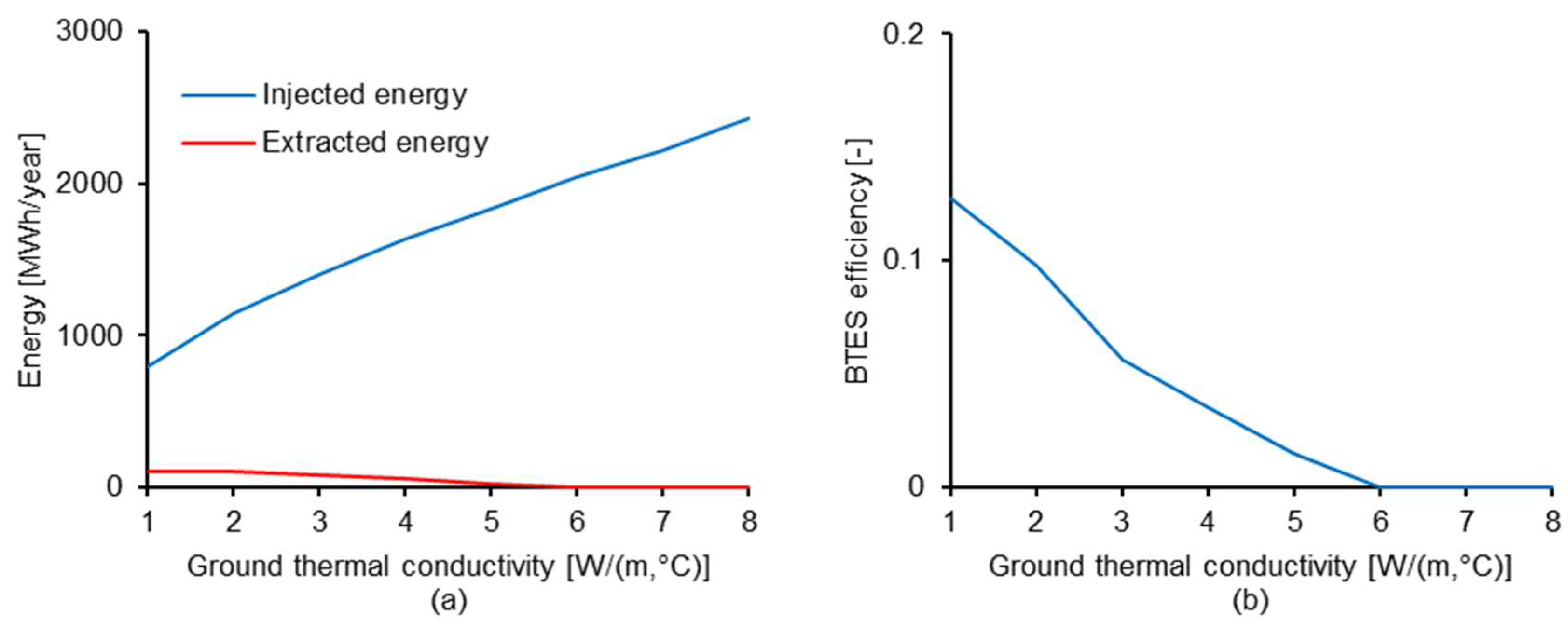
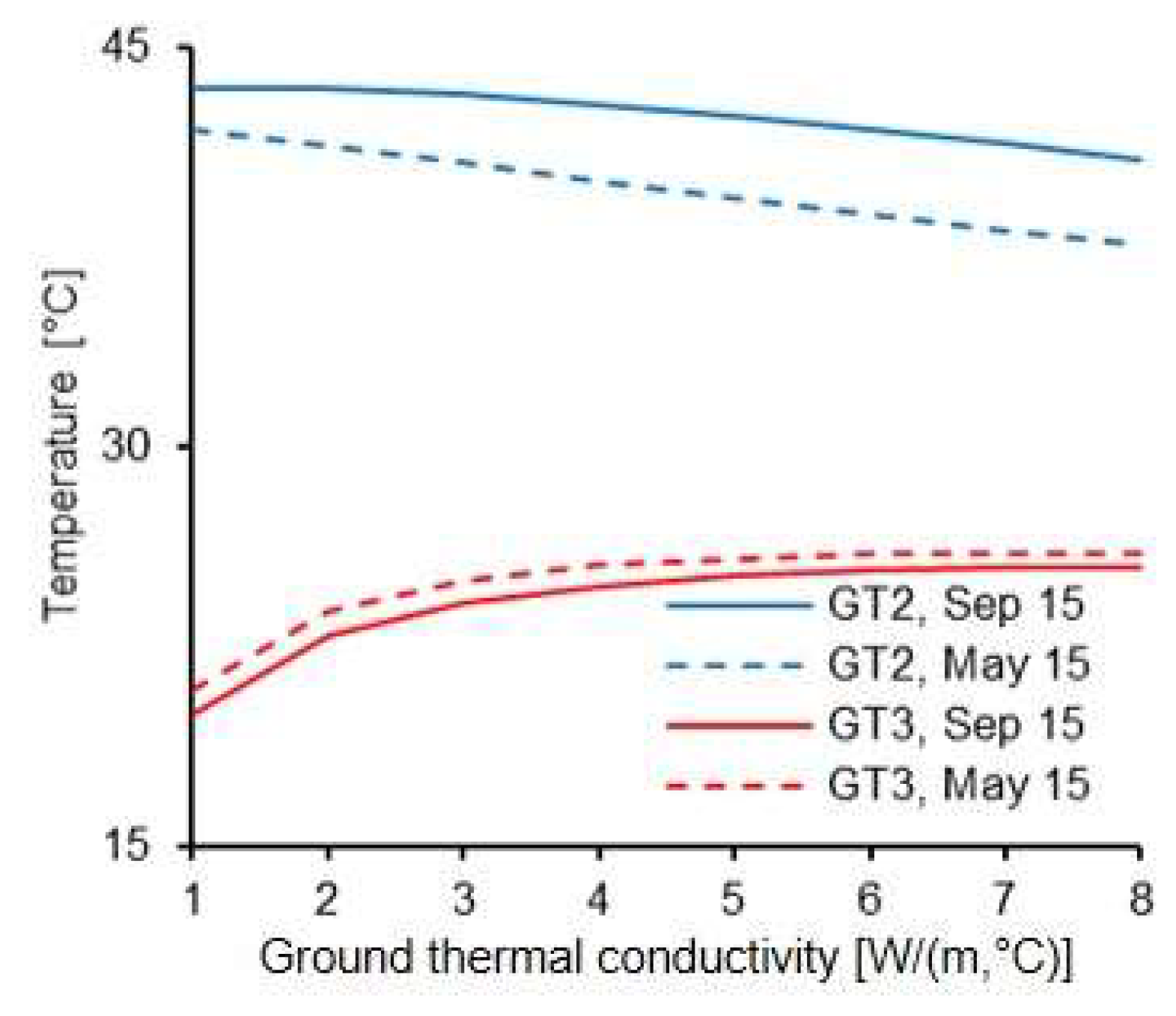
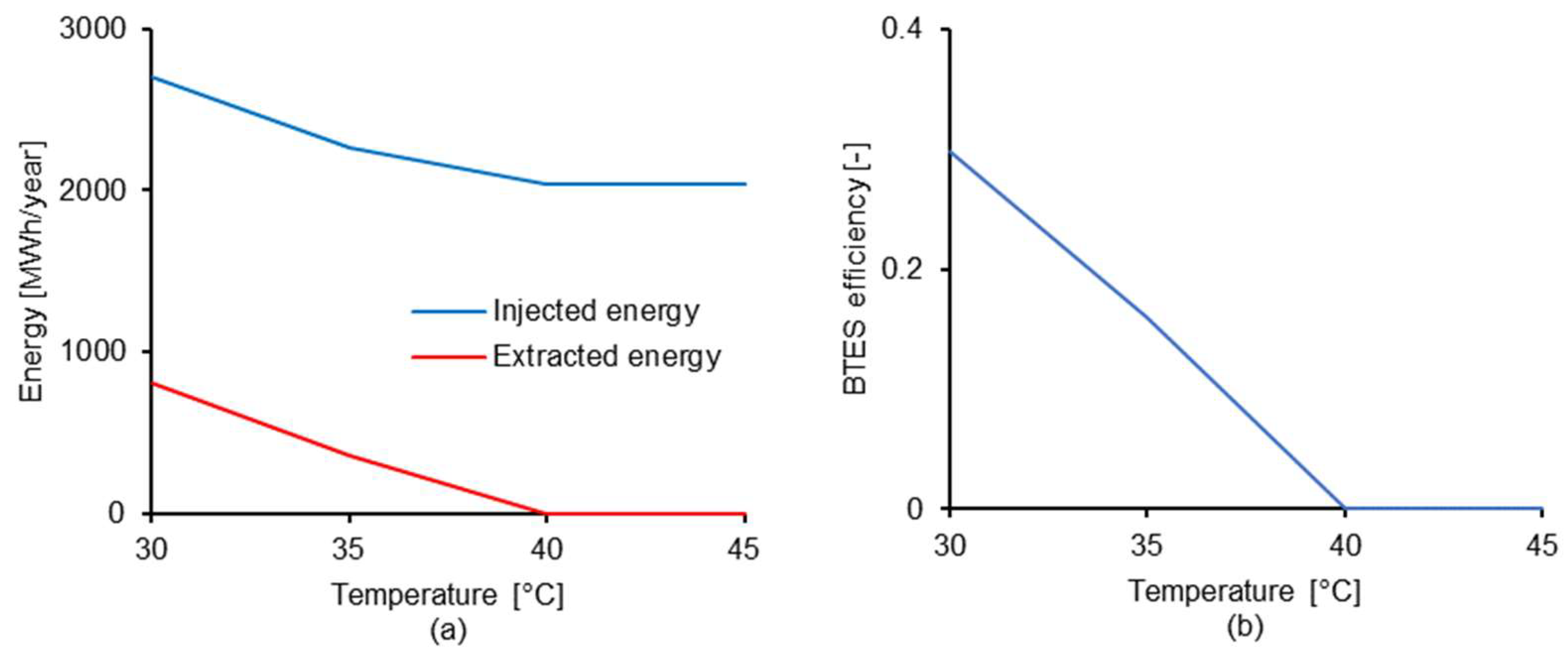
| Case | Mass Flow of Actual (%) | Flow Temperature of Actual (%) | Mass Flow Rate (kg/s) | Flow Temperature (°C) |
|---|---|---|---|---|
| Case 1 | 75 | 200 | 10 | 80 |
| Case 2 | 150 | 150 | 20 | 60 |
| Case 3 | 100 | 150 | 13 | 60 |
| Case 4 | 75 | 150 | 10 | 60 |
| Case 5 | 150 | 100 | 20 | 40 |
| Case 6 | 100 | 100 | 13 | 40 |
| Parameter | Values | Case |
|---|---|---|
| Borehole spacing (m) | 1, 2, 3, 4, 5, 6, 7, 8 | 1–6 |
| Borehole depth (m) | 84, 114, 144, 174, 204, 234, 264, 294, 324 | 1–6 |
| Modelled ground thermal conductivity (W/(m·°C)) | 1, 2, 3, 4, 5, 6, 7, 8 | 6 |
| Minimum useful storage temperature (°C) | 30, 35, 40, 45 | 6 |
© 2019 by the authors. Licensee MDPI, Basel, Switzerland. This article is an open access article distributed under the terms and conditions of the Creative Commons Attribution (CC BY) license (http://creativecommons.org/licenses/by/4.0/).
Share and Cite
Nilsson, E.; Rohdin, P. Empirical Validation and Numerical Predictions of an Industrial Borehole Thermal Energy Storage System. Energies 2019, 12, 2263. https://doi.org/10.3390/en12122263
Nilsson E, Rohdin P. Empirical Validation and Numerical Predictions of an Industrial Borehole Thermal Energy Storage System. Energies. 2019; 12(12):2263. https://doi.org/10.3390/en12122263
Chicago/Turabian StyleNilsson, Emil, and Patrik Rohdin. 2019. "Empirical Validation and Numerical Predictions of an Industrial Borehole Thermal Energy Storage System" Energies 12, no. 12: 2263. https://doi.org/10.3390/en12122263
APA StyleNilsson, E., & Rohdin, P. (2019). Empirical Validation and Numerical Predictions of an Industrial Borehole Thermal Energy Storage System. Energies, 12(12), 2263. https://doi.org/10.3390/en12122263




